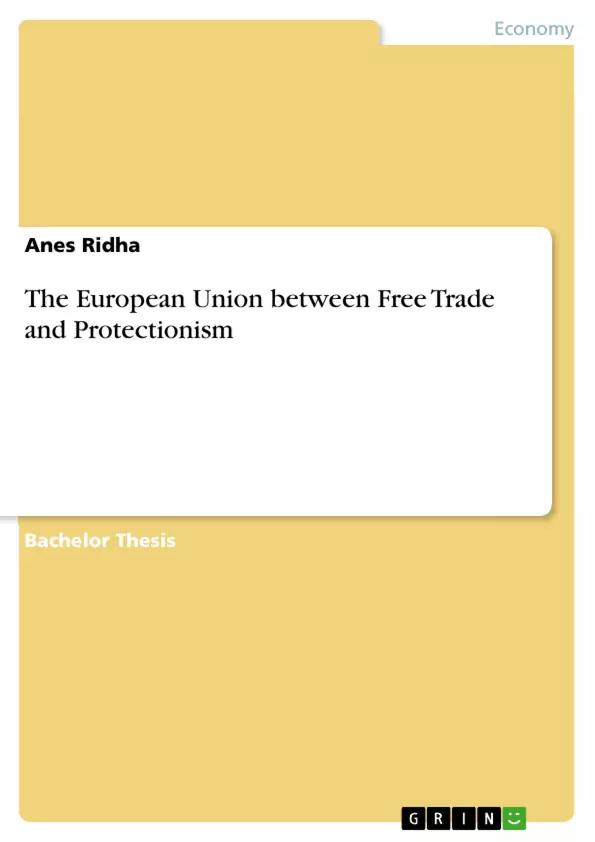This thesis deals with the European Union and its tension between free trade on the one hand and protectionism on the other. A closer look at the EU reveals an inconsistency in its policies. Thus, in its domestic policy, the EU represents a strongly free-trade-oriented attitude by standing for a single market without any restrictions. Externally, however, the EU tends to take a protectionist stance in some sectors, such as agricultural policy.
In order to be able to deal with this topic more exactly, all bases must be understood as for example terms and theories. For this purpose, the concept of free trade and protectionism will be introduced in detail. Then, in chapter two, the term "economic justification of free trade" is defined in more detail.
Inhaltsverzeichnis (Table of Contents)
- 1. Introduction
- 2. Economic justification of free trade
- 2.1 Definition and origin of free trade
- 2.2 Free trade as an institutionalized fundamental value
- 2.3 Reasons for free trade
- 2.4 Summary
- 3. Economic justification of protectionism
- 3.1 Definition and origin of protectionism
- 3.2 Forms and instruments of protectionism
- 3.3 Reasons for protectionism
- 3.4 Summary
- 4. The European Union as the engine of free trade – A historic development of free trade using the example of the internal market.
- 4.1. The European Single Market
- 4.1.1 Definition
- 4.1.2. The European Economic Area (EEA) and its fundamental freedoms
- 4.1.3. Economic and Monetary Union (EMU)
- 4.2. Historical development of the European single market
- 4.1. The European Single Market
- 5. The European Union as an engine of protectionism – A historic development of protectionism using the example of the Common Agricultural Policy (CAP)
- 5.1. The Common Agricultural Policy (CAP) - Definition and Tasks
- 5.2. Objectives, financing and development of the Common Agricultural Policy (CAP)
- 5.3. The external protection of the Common Agricultural Policy
- 6. Summary
Zielsetzung und Themenschwerpunkte (Objectives and Key Themes)
This paper analyzes the tension between free trade and protectionism in the European Union (EU), particularly considering its internal market and the Common Agricultural Policy (CAP). The main goal is to understand the EU's stance on free trade and protectionism through the historical development of its policies, the underlying economic justifications, and the ongoing debates surrounding these concepts.
- The economic justifications of free trade and protectionism.
- The historical development of free trade and protectionism within the EU.
- The EU's internal market as an example of free trade.
- The Common Agricultural Policy (CAP) as an example of protectionism.
- The tension between free trade and protectionism within the EU.
Zusammenfassung der Kapitel (Chapter Summaries)
Chapter 1 introduces the topic of free trade and protectionism in the context of globalization and the increasing importance of international economic relations. Chapter 2 provides a detailed definition of free trade, tracing its origins and highlighting its institutionalized role in the global economy. It then explores the economic reasons for promoting free trade policies. Chapter 3 similarly defines protectionism and explores its historical roots and various forms, specifically non-tariff and tariff barriers to trade. It also examines the economic justifications for protectionist measures.
Chapter 4 focuses on the EU's internal market as a model of free trade, defining the concept and highlighting its importance. It then presents the European Economic Area (EEA) and the European Economic and Monetary Union (EMU), both critical components of the European Single Market. The chapter concludes by exploring the historical development of the European Single Market from the Second World War onward.
Schlüsselwörter (Keywords)
This paper explores the tension between free trade and protectionism in the EU, with a focus on the internal market and the Common Agricultural Policy (CAP). Key terms include free trade, protectionism, globalization, internal market, European Single Market, European Economic Area (EEA), Economic and Monetary Union (EMU), Common Agricultural Policy (CAP), tariffs, non-tariff barriers, economic justifications, historical development, and the EU's policies on trade.
- Citar trabajo
- Anes Ridha (Autor), 2018, The European Union between Free Trade and Protectionism, Múnich, GRIN Verlag, https://www.grin.com/document/1168384



